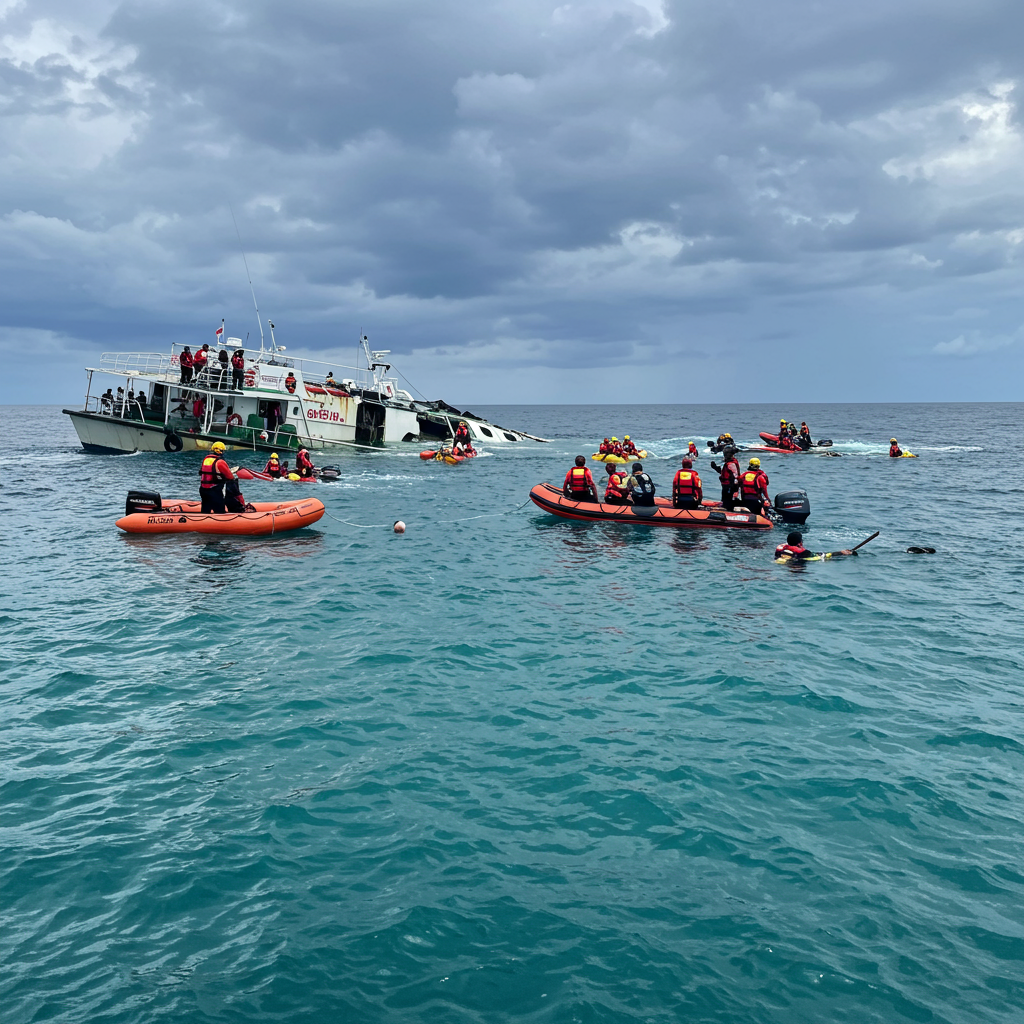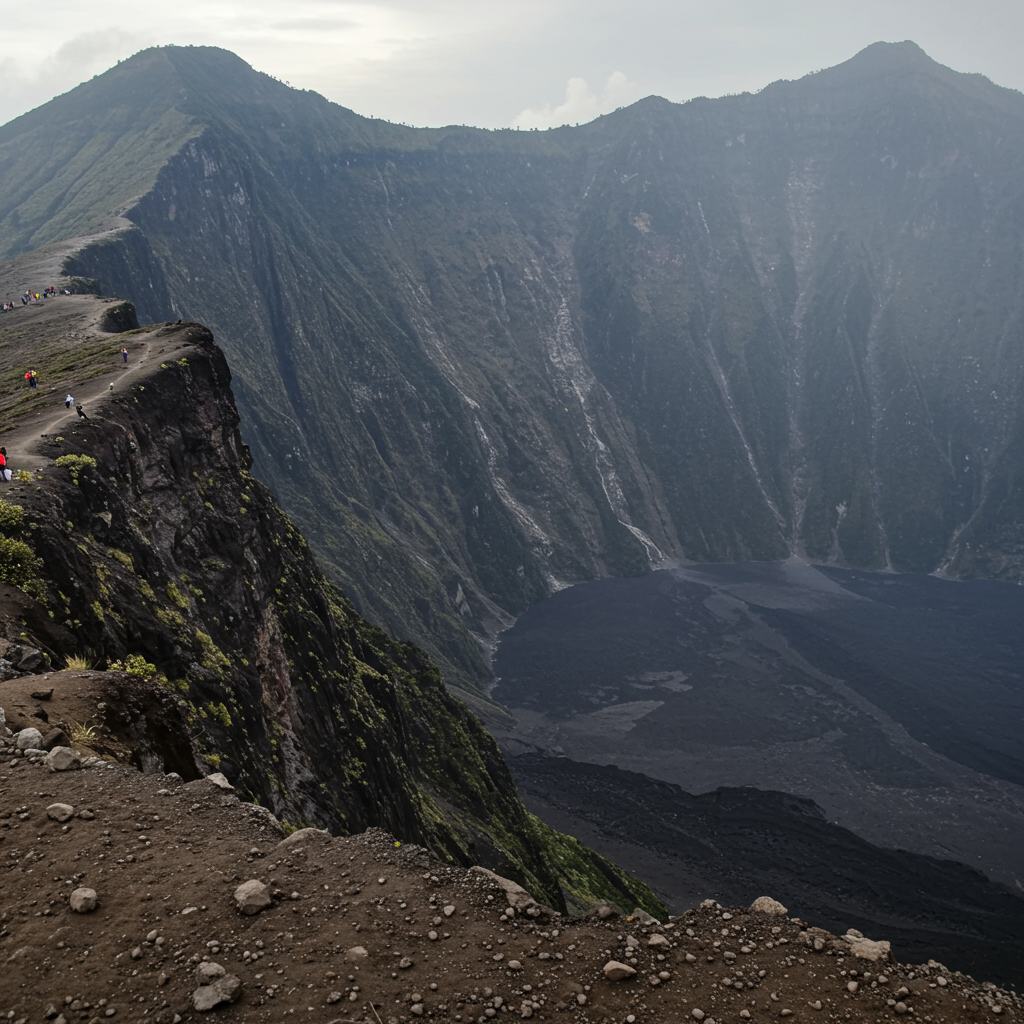A deadly ferry accident struck near Bali, Indonesia, late Wednesday, July 2, 2025. The disaster left at least four people dead. Rescuers are urgently searching for dozens more missing in the waters off the popular resort island. This incident highlights ongoing concerns about maritime safety standards in the vast Indonesian archipelago.
The KMP Tunu Pratama Jaya ferry was carrying a total of 65 people. This included 53 passengers and 12 crew members. It also transported 22 vehicles, notably 14 trucks. The vessel encountered trouble and sank approximately 25 to 30 minutes after departing. It had left the Ketapang port in Banyuwangi, East Java. Its destination was the Gilimanuk port on Bali, a relatively short journey across the Bali Strait.
Urgent Search for Survivors Underway
Search and rescue operations commenced immediately following the sinking. As of Thursday afternoon, July 3, authorities confirmed that 31 people had been pulled from the water alive. This left 30 individuals still unaccounted for from the initial manifest. Rescue efforts involved a significant deployment of resources. Teams used a helicopter, nine boats including tug boats and inflatable vessels. Fishermen and local residents also assisted from the shore.
Initial rescue attempts overnight faced severe challenges. Strong waves, reportedly reaching up to 2.5 meters (about 8 feet) high, combined with darkness, hampered visibility and navigation. However, conditions improved significantly by Thursday morning. Authorities reported calmer seas and better weather aided the intensified search. Rescue teams initially focused their efforts on the surface. They concentrated on the area between the sinking site and Gilimanuk port. This was based on where the first victims were located.
Understanding the Cause and Impact
Investigators are working to determine the exact cause of the tragedy. Initial reports point to “bad weather” as a contributing factor. This was cited by officials like Cabinet Secretary Teddy Indra Wijaya. However, survivors provided another potential clue. Some survivors told rescuers they believed there might have been a leak in the ferry’s engine room before it went down. The vessel reportedly could not be reached by radio early in its journey. Later contact by other ships indicated it was already tilting dangerously.
The suddenness of the sinking was described by survivors. One survivor, 64-year-old Supardi, recounted the harrowing experience from a hospital bed. He initially thought about jumping into the sea as the ship tilted. However, the ferry sank too quickly. He was submerged with the vessel before managing to climb towards the surface from about 7 meters (23 feet) deep. He and three others used life jackets to stay afloat until rescue. Banyuwangi Police Chief Rama Samtama Putra noted that many rescued individuals were found unconscious. They had drifted in the choppy waters for hours, battling exhaustion and exposure. Another survivor, Eka Toniansyah, who lost his father in the accident, also spoke of the rapid tilting and sinking.
A Troubling Pattern of Marine Accidents
This fatal incident tragically underscores persistent issues with marine safety in Indonesia. As the world’s largest archipelago, comprised of over 17,000 islands, ferry transport is crucial for connecting communities and moving goods and people. However, accidents are unfortunately common. This frequency is often linked to factors such as lax safety standards, vessels being overloaded beyond capacity, inadequate maintenance, and insufficient life-saving equipment onboard. Challenging weather conditions also pose significant risks.
The route between Java and Bali is one of Indonesia’s busiest. It’s a vital artery for both local travel and tourism, typically taking about an hour for the crossing. The KMP Tunu Pratama Jaya sinking is not an isolated event. Recent years have seen other serious maritime incidents in the country. These include a boat capsizing off Bali in March that resulted in a fatality and a major ferry disaster on Sumatra island in 2018 where over 150 people drowned. The uneven enforcement of safety regulations remains a long-standing challenge for authorities.
Response and Broader Concerns
News of the disaster caused immediate distress among families. Relatives rushed to the departure port in Ketapang, Banyuwangi, seeking information. Many were visibly panicked or weeping as they desperately hoped for news of their loved ones among the rescued. Survivors are receiving medical care at nearby facilities, including Jembrana Regional Hospital in Bali.
Indonesia’s President Prabowo Subianto, who was traveling internationally at the time, ordered an immediate and urgent emergency response to the disaster. The government’s focus remains on the search and rescue operation. Beyond the immediate crisis, the sinking raises concerns for Bali’s vital tourism industry. Ferries are essential for moving both tourists and goods to the island. A decline in traveler confidence regarding inter-island ferry safety could potentially impact tourism-related businesses. Authorities are under pressure to enhance oversight and safety protocols, particularly when operating during adverse weather, to prevent future tragedies and maintain traveler trust.
Frequently Asked Questions
What caused the KMP Tunu Pratama Jaya ferry to sink near Bali?
Authorities and survivors have suggested potential causes for the sinking. Officials initially attributed the accident to “bad weather,” citing challenging sea conditions with high waves. Separately, survivors reported a possible leak in the ferry’s engine room shortly before it sank. The official investigation is underway to determine the precise factors that led to the disaster.
Where exactly did the ferry sinking near Bali occur?
The KMP Tunu Pratama Jaya ferry sank in the Bali Strait. This waterway separates the islands of Java and Bali. The incident happened approximately 25 to 30 minutes after the ferry departed from the Ketapang port in Banyuwangi, East Java. It was en route to the Gilimanuk port on the western side of Bali.
How common are ferry accidents in Indonesia?
Unfortunately, ferry accidents are relatively common occurrences in Indonesia. This is due to the nation’s geography as a vast archipelago that relies heavily on sea transport. Factors contributing to the frequency of incidents include issues with enforcing safety regulations, potential overloading of vessels, inadequate maintenance, and challenging weather conditions that can quickly impact sea travel safety.
The search continues for those still missing, with rescue teams working tirelessly. The incident serves as a stark reminder of the critical need for stringent safety measures in maritime transport across the Indonesian islands.



